Growing up in Scotland: parenting and children's health
This publication reports which aspects of day-to-day parenting are important to children’s health and whether variations in parenting account for social inequalities in child health outcomes.
CHAPTER 2 MEASURING CHILD HEALTH AND FAMILY ADVERSITY
2.1 Introduction
This chapter describes the health and health behaviours of children in the Growing Up in Scotland study as they approached their fifth birthdays. It also develops a measure of family adversity (from various social background characteristics), and examines associations between child health and the adversity measure.
2.2 Key findings
- A minority of children were in poor general health (5%) or had a long-term illness that limited their daily activities (4%).
- More than one in ten children (13%) had mild or severe social, emotional and behavioural difficulties.
- Almost one in five children (18%) had three or more health problems in the past year, and 11% had experienced three or more accidents or injuries requiring medical attention since birth.
- A sizeable minority of children (17%) had some tooth decay.
- More than a third of children reported low physical activity (38%) and a similar proportion showed high screen time (39%).
- Around a third (35%) consumed snacks with a high sugar or fat content more than once a day, and two-thirds (69%) lacked a varied fruit and vegetable diet.
- Poor health and poor health behaviours are related.
- An index of family adversity was constructed using eight different indicators of health risk from maternal, family and area characteristics including poverty and maternal depression. Children who were reported to have higher levels of adversity were more likely to have poor child health and health behaviours, with the exception of physical activity.
2.3 Health measures
Six measures were selected to cover children's physical and mental health. Five of these measures were reported by the child's mother at sweep 5. They were:
- General health.
- Limiting long-term illness (whether the child has a persistent illness or disability that restricts his or her ability to play or participate in other activities that are normal for children of the same age).
- Social, behavioural and emotional difficulties (Strengths and Difficulties Questionnaire).
- Health problems (other than long-term illnesses) in the last 12 months.
- Dental health.
A further measure was taken from information reported by mothers at all five sweeps:
- Accidents or injuries for which the child was taken to the doctor, dentist, health centre, or hospital.
For ease of presentation, this report has used binary measures which split the children into two groups depending on their answers. The way in which this was done is explained in the following sections. Where possible, the aim is to create a meaningful split into children with poorer and better health, although for some measures the dividing line is necessarily somewhat arbitrary and reflects the need to have sufficient numbers in each group for analysis purposes. The health measures are summarised in Table 2.1 and explained in more detail below.
Table 2.1 Summary table of child health outcomes
| % |
Bases Weighted |
Unweighted |
||
|---|---|---|---|---|
| General health |
Very good or good |
95 |
3304 |
3339 |
| Fair, bad or very bad |
5 |
175 |
147 |
|
| Total |
100 |
3478 |
3486 |
|
| Limiting long-standing illness |
No |
96 |
3339 |
3359 |
| Yes |
4 |
139 |
127 |
|
| Total |
100 |
3478 |
3486 |
|
| Total difficulties score |
Normal |
87 |
3002 |
3080 |
| Borderline or severe |
13 |
430 |
366 |
|
| Total |
100 |
3432 |
3446 |
|
| Number of health problems last |
0-2 |
82 |
2859 |
2904 |
| 3 or more |
18 |
619 |
582 |
|
| Total |
100 |
3478 |
3486 |
|
| Number of accidents/injuries requiring medical attention |
0-2 |
89 |
3104 |
3140 |
| 3 or more |
11 |
373 |
344 |
|
| Total |
100 |
3477 |
3484 |
|
| Dental health |
No decay |
83 |
2886 |
2969 |
| Decay, filling or tooth extracted |
17 |
583 |
511 |
|
| Total |
100 |
3469 |
3480 |
Note: Reported at sweep 5 (age 4-5 years) unless otherwise indicated
- Very few children reported poor general health (5%) or a limiting long-term illness (4%).
- A little more than one in ten children (13%) had mild or severe social, emotional and behavioural difficulties.
- Almost one-fifth (18%) had three or more health problems in the past year. Accidents and injuries were less common; 11% had experienced three or more accidents or injuries requiring medical attention since birth.
- Although the majority of children had no tooth decay, a sizeable minority of children (17%) reported having decay, a filling or a tooth extracted.
2.3.1 General health
Most mothers said their child's health was either 'very good' or 'good' with only 5% reporting their child's health as 'fair', 'bad 'or 'very bad' (see Figure 2-A). In this report, we define this second group as being in poor general health when compared to most children. The prevalence of poor health was comparable to that found for 4-5 year-olds in the Scottish Health Survey 2008/9 (4%). As this is a key measure, variations in general health were compared across each of the health outcome measures discussed below.
Figure 2-A General health of child
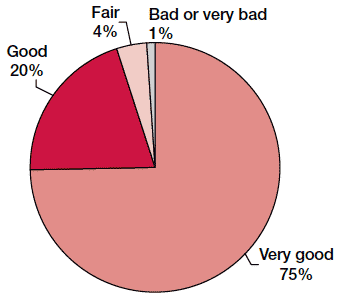
n = 3486 unweighted
2.3.2 Limiting long-term illness
A small percentage of mothers (4%) reported that their child had a limiting long-term illness. This figure is comparable to that found for 4-5 year olds in the 2008/09 Scottish Health Survey (3%). Compared with the whole sample, a much higher proportion of children with a limiting long-term illness (two out of every five, about eight times higher than in the whole sample) were in poor general health.
2.3.3 Social, behavioural and emotional problems
The Goodman Strengths and Difficulties questionnaire ( SDQ) (Goodman 1997) was used to measure children's social, emotional and behavioural development. This report uses the total difficulties SDQ score, summarising information from 20 questions administered to mothers covering four domains of their children's mental health 3 . These domains comprised:
- Conduct problems: often fights, often has temper/tantrums, not generally obedient, argumentative with adults, can be spiteful to others.
- Inattention-hyperactivity: is restless/overactive, constantly fidgeting, easily distracted, cannot stop and think out before acting, does not see tasks through to end.
- Emotional symptoms: is often unhappy, often complains of headaches, many worries, nervous or clingy, many fears.
- Peer problems: is rather solitary, tends to play alone; does not have at least one good friend, not generally liked by other children, picked or bullied by other children, gets on better with adults than other children.
Mothers were asked whether each statement was 'not true' (0), 'somewhat true' (1) or 'certainly true' (2). This report divides children with scores in the normal range (0-13) from those with scores that were either moderate (14-16) or severe (17-40). Thirteen per cent of children had a total difficulties score that was indicative of, or bordered on, severe social, behavioural and/or emotional problems (sometimes referred to as 'poor mental health' in this report). A higher proportion of this group (16%) were in poor general health compared to the whole sample (5%). The percentage with moderate or severe difficulties is comparable to that found in earlier analysis of data from the slightly older child cohort in GUS (Bradshaw, 2010).
2.3.4 Health problems
Most children had at least one health problem in the 12 months before the sweep 5 interview (Figure 2-B). Problems reported by at least 5% of mothers were colds (84%), skin complaints (16%), ear or hearing problems (15%), chest infections (10%), eye or sight problems (9%), wheezing or asthma (6%) and sleeping difficulties (6%).
The survey did not collect information on the severity of different problems or whether they received medical attention, so this report uses the total number of problems as a measure of health. In this report we have differentiated those with three or more problems (18%) from the rest. In this group, 15% were in poor general health (about three times the proportion in the overall survey population).
Figure 2-B Percentage of children with different numbers of health problems in last 12 months
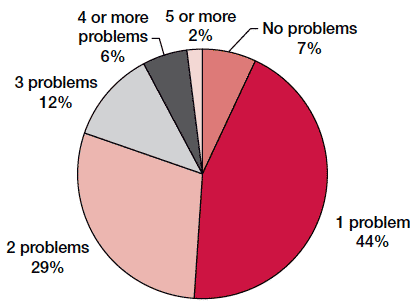
n = 3486 unweighted
2.3.5 Accidents and injuries
Around six in ten children had at least one accident or injury since birth for which their parent consulted a medical specialist (doctor, dentist, health centre, or hospital)
(Figure 2-C). This report uses information across all sweeps to introduce more variability into the data compared to a measure based on sweep 5 data alone. We have differentiated those with three or more accidents or injuries (11% of the sample) from the rest. More of this accident-prone group were in poor general health than the whole sample (10% compared to 5%), but the difference was not statistically significant.
Figure 2-C Percentage of children according to number of accidents/injuries since birth
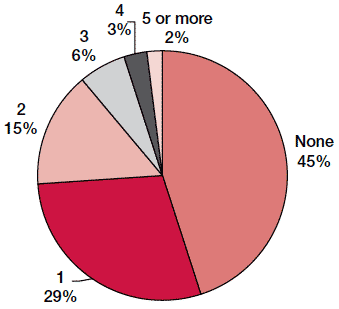
n = 3486 unweighted
2.3.6 Dental health
Mothers were asked about their child's current dental health and whether their child had ever had various types of dental treatment. A minority of children had been given one or more fillings (7%) or had one or more teeth extracted because of decay (3%). Most children (88%) were said by their mothers to have 'perfectly healthy' teeth, with 11% reporting some decay and 1% a lot of decay. These figures vary somewhat from official statistics on child dental health provided in the 2010 National Dental Inspection Program (Macpherson et al. 2010). Results from the inspection program show that 36% of Scottish children in P1 were found to have at least some obvious decay. The official statistics are provided via inspection by a dental health professional rather than by parental report. The lower figure in the GUS data therefore suggests that a reasonable proportion of mothers are not aware of tooth decay in their children.
In this report we have combined children who had experienced a filling and/or tooth extraction with those who their mothers said had any current decay. This gave 17% of children who were in poor dental health for their age group. The proportion of these children who were in poor general health (9%) was above the proportion in the whole population, but the difference was not statistically significant.
2.4 Health behaviour measures
Four child health behaviours were selected, all reported by mothers at sweep 5:
- Physical activity
- Screen time (time spent watching television and/or using a computer or games console)
- Fruit and vegetable consumption
- Snacking
For ease of presentation this report uses binary measures. The derivation of each measure is explained in the following sections and a summary is provided in Table 2.2.
Table 2.2 Summary of child health behaviour outcomes
| % |
Bases Weighted |
Unweighted |
||
|---|---|---|---|---|
| Physical activity |
High |
62 |
2161 |
2191 |
| Low |
38 |
1304 |
1282 |
|
| Total |
100 |
3466 |
3473 |
|
| Screen time on term-time week day |
Up to 2 hours |
61 |
2090 |
2193 |
| More than 2 hours |
39 |
1355 |
1259 |
|
| Total |
100 |
3445 |
3452 |
|
| Fruit and vegetable consumption previous day |
5 or more different fruits and/or vegetables |
31 |
1081 |
1160 |
| Fewer than 5 different fruits/vegetables |
69 |
2390 |
2318 |
|
| Total |
100 |
3471 |
3478 |
|
| Frequency of sweets, crisps, sugary soft drinks |
Less frequent |
65 |
2271 |
2358 |
| Any more than once a day |
35 |
1208 |
1128 |
|
| Total |
100 |
3478 |
3486 |
Note: Reported at sweep 5 (age 4-5 years)
- More than a third of children reported low physical activity (38%) and a similar proportion showed high screen time (39%).
- Around a third (35%) consumed snacks with a high sugar or fat content more than once a day, and two-thirds (69%) lacked a varied fruit and vegetable diet.
2.4.1 Physical activity
Mothers were asked whether their child had done any of the following activities during the past week for at least ten minutes (including at school, pre-school or nursery): riding a bicycle, throwing or kicking a ball, running and/or jumping, playing on a trampoline, swimming, playing at a soft play area or ball swamp, playing at a play/swing park, or other activities (a list of activities was used to prompt parents).
The total time spent on each activity mentioned in the past week was recorded using the following 6-point scale: (1) less than 15 minutes (2) 15 minutes to less than 30 minutes (3) 30 minutes to less than 1 hour (4) 1 hour to less than 2 hours (5) 2 hours to less than 3 hours (6) 3 hours or more. This score was converted to an estimated active minutes per week using the midpoint of each time range for scores 2-5, 10 minutes for a score of 1 and 210 minutes for a score of 6. Times spent on different activities in a week were added together, and the total was divided by seven to give an approximate daily physical activity measure. This was divided into those above and below the minimum recommended daily 60 minutes of moderate to vigorous physical activity for this age group (National Institute for Health and Clinical Excellence 2009).
Just over a third of children (38%) fell below the guideline using this measure. Whilst the wide time ranges possible in some of the categories, especially those with the longest durations, may have resulted in over estimation of the number of children failing the guideline, the measure is likely to indicate children who are less physically active than their peers. The percentage estimated as meeting physical activity guidelines (62%) is similar to the 68% of all 2-4 year olds and 75% of 5-7 year olds reported meeting the guidlines in the 2008/09 Scottish Health Survey, although there were some differences in the questions used between GUS and the Scottish Health Survey.
2.4.2 Screen time
Total screen time was calculated from two questions that mothers were asked about how long their child usually spent watching TV or using computers or games consoles on an average term-time week day. Screen time has been used extensively as an indicator of sedentary activity. Excessive TV and electronic games use has also been associated with emotional and behavioural problems in children (Pagani et al. 2010; Page et al. 2010). There are no UK guidelines on the amount of screen time for young children, but this report has divided children into those spending up to 2 hours (61%) and those spending more than 2 hours using TV or electronic games (39%), reflecting United States and Australian recommended guidelines (Committee on Public Education 2001; Department of Health and Ageing 2004).
2.4.3 Fruit and vegetable consumption
This was derived from two questions about the number of different types of fruit and vegetables consumed the previous day. Fruit and vegetable consumption in the whole sample was generally low, with the average number of different types being 3.5 in the previous day and 7% consuming no fruit or vegetables.
The report divides children into a 'low consumption' group (those who had consumed less than five different fruits or vegetables, 69%) and a 'high consumption' group (those who had eaten five or more, 31%). This is an approximate measure for the number of children eating at least five portions (rather than different types) of fruit and vegetables recommended by UK Government guidelines (Food Standards Agency 2001).
2.4.4 Snacking on items with high sugar/fat content
Regular snacking on sweets or chocolate, sugary soft drinks (excluding fruit juices) or crisps was derived from three questions about the frequency of consumption of these items. 'Sweets' were defined as a whole packet of sweets or chocolate bar, not individual sweets. Frequency was measured using an 8-point scale: (1) more than once a day (2) once a day (3) 5 or 6 times a week (4) 2 to 4 times a week (5) once a week (6) 1 to 3 times per month (7) less often and (8) never.
Twenty-three per cent reported eating crisps, 49% eating sweets or chocolate and 41% consuming sugary drinks at least daily. These percentages are comparable to those found for all children aged 2-15 years in the Scottish Health Survey 2008/9, with 36% eating crisps, 53% sweets or chocolate and 37% consuming sugary drinks daily.
In terms of more frequent consumption, in the GUS data 15% of children consumed crisps, 10% sweets or chocolate and 29% sugary drinks more than once a day. In this report, children who consumed any of these high sugar or fat items more than once a day (35%) were contrasted with the rest (65%).
2.4.5 Associations between health behaviours and child health
Children with poor health behaviours were more likely to be in poor general and mental health (poor mental health being measured as having a moderate or severe total difficulties score). In addition, high screen time, regular snacking on sweets/crisps/sugary drinks and low fruit and vegetable consumption were all associated with poor dental health (Figure 2-D). The association between high screen time and poor dental health may be driven by the relatively high consumption of sugary snacks by children who watch a lot of TV (see Marryat et al. 2009).
Note that these associations do not indicate that health behaviours necessarily contributed towards poorer health. In some cases, poor health may limit a child's activities, or there may be other factors responsible for the associations found.
Figure 2-D Associations between health behaviours and poor health
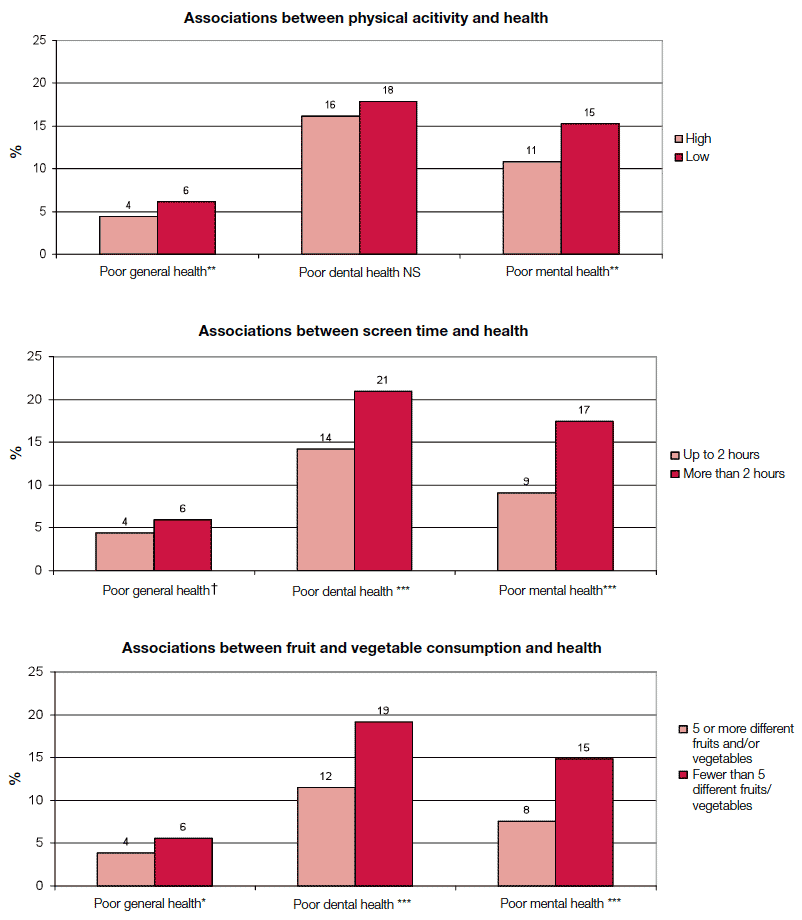
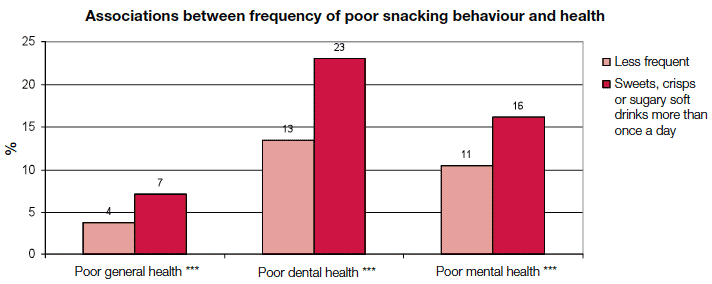
Note: Significance levels: † denotes p<0.1, *p<0.05, **p<0.01 and *** p<0.001, NS = not significant
For full set of figures, see section 2.1 in the Technical Appendix.
2.5 Family adversity
Several characteristics of the mother and family were associated with poorer child health and health behaviours. The following characteristics of mothers were examined:
- Ethnicity
- Aged under 25 years at birth of cohort child
- No educational qualifications
- Maternal depression 4 .
In addition, the following family circumstances were considered:
- Natural father not present in household throughout sweeps 1 to 5
- Living in social rented housing (sweep 1)
- Low income (family in the lowest quintile (20%) of mean equivalised household income, at each of sweeps 1 to 5)
- Living in a deprived neighbourhood (in the highest SIMD 5 quintile).
This report collectively terms the above factors as 'family adversity'.
Table 2.3 shows the prevalence of these factors.
Table 2.3 Distribution of family adversity risk factors among the sample of natural mothers
| Column % |
Bases |
|||
|---|---|---|---|---|
| Weighted |
Unweighted |
|||
| Ethnic group |
White |
97 |
3358 |
3395 |
| Minority |
3 |
119 |
90 |
|
| Mother's education sweep 1 |
Some qualifications |
91 |
3165 |
3267 |
| None |
9 |
310 |
217 |
|
| Natural father in household sweeps 1-5 |
Yes |
72 |
2516 |
2766 |
| No |
28 |
962 |
720 |
|
| Mother's age at birth of cohort child |
25 years or older |
75 |
2621 |
2887 |
| Under 25 years |
25 |
857 |
599 |
|
| Housing tenure sweep 1 |
Owner/private rented |
73 |
2548 |
2781 |
| Social rented |
27 |
927 |
704 |
|
| Area deprivation |
Quintiles 1 to 4 |
77 |
2687 |
2902 |
| Most deprived quintile |
23 |
791 |
584 |
|
| Household income (mean sweeps 1-5) |
Quintiles 2 to 5 |
70 |
2419 |
2692 |
| Lowest quintile |
30 |
1042 |
778 |
|
| Maternal depression |
SF12 Normal range |
85 |
2955 |
3027 |
| More than 1 SD below pop. mean score |
15 |
523 |
459 |
|
The adversity factors are related to each other to some extent. For example, families on low incomes are more likely to live in social housing, and to live in deprived neighbourhoods than are those on high incomes, and young mothers are more likely to lack educational qualifications than older mothers.
We examined associations between these eight individual family adversity factors and child health and health behaviours using multivariate analyses 6 . The results showed that each individual adversity factor had a statistically significant association with one or more of the child health and health behaviour outcomes, even after controlling for the effect of other family adversity measures. This suggests that children in families who experience greater adversity may report poorer health outcomes, similar to findings in a large US study (Larson et al. 2008).
An index of family adversity was devised by counting the number of different factors experienced by the child's family. Table 2.4 shows the distribution of the number of adversity factors in the survey population. A large proportion of children (42%) experienced no adversity, and the maximum score was 7 out of a possible 8 (not shown). Because of low numbers, the top four categories were combined into a group with 5 or more factors (10%).
Table 2.4 Distribution of the number of adversity factors* in the Family Adversity Index in the Sample Population
| % |
Bases |
|||
|---|---|---|---|---|
| Weighted |
Unweighted |
|||
| Number of adversity factors |
0 |
42 |
1478 |
1785 |
| 1 |
17 |
598 |
640 |
|
| 2 |
11 |
369 |
348 |
|
| 3 |
11 |
368 |
287 |
|
| 4 |
9 |
325 |
225 |
|
| 5 or more |
10 |
340 |
201 |
|
* Factors were minority ethnic group, mother with no educational qualifications, mother younger than 25 at birth of cohort child, maternal depression, biological father not present throughout sweeps 1 to 5, in social rented housing sweep1, in highest area deprivation quintile, in lowest quintile mean household equivalised income sweep 1- 5.
2.5.1 Associations between family adversity and child health
We examined associations between family adversity and each health outcome. All were statistically significant (p<0.001).
Figure 2-E shows that the prevalence of poor health among children aged 4-5 increased with a greater number of family adversity factors, although the pattern of this increase varied somewhat across health outcomes. The increase with family adversity was particularly steep for poor mental health (difficulties score) and poor dental health. This suggests that these two outcomes are more strongly related to family adversity than the others.
An exception to the picture of worsening health with increased adversity was seen for limiting long-term illness. Compared to children in families with a zero family adversity score, levels of limiting long-term illness were greater in children with a family adversity score of one or more, but did not show a clear increase with a higher adversity score.
Figure 2-E Associations between health behaviours and poor health
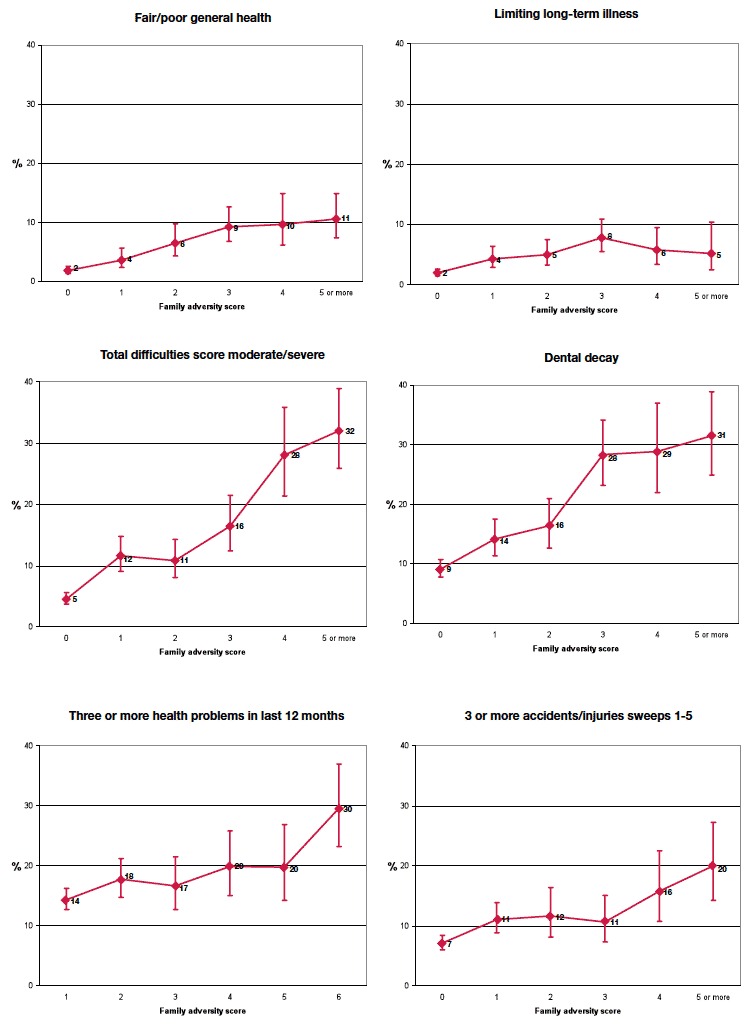
Note: Bars show 95% confidence intervals. Overall associations between family adversity and poor health were all statistically significant (p<0.001).
2.5.2 Associations between family adversity and health behaviours
The same analysis was undertaken for health behaviours. Associations between health behaviours and family adversity are presented in Figure 2-F.
Screen time, fruit and vegetable consumption and poor snacking were each significantly associated with family adversity (p<0.001). There was an overall increase in poor behaviour with increasing adversity for these three behaviours - that is, children with greater levels of adversity tended to report poorer health behaviour - although the pattern of poor health behaviours in relation to family adversity varied according to the behaviour. Steeper increases with greater family adversity were found for screen time and poor snacking than for fruit and vegetable consumption.
Only physical activity did not show a clear trend with increasing family adversity despite previous research suggesting such a relationship. Previous analysis of GUS data found that lower levels of household income and greater area deprivation were both associated with a lower activity score for children who were almost 3 years old, although this score included time spent watching television and playing on computers in the activity measure, along with various active behaviours such as running, jumping and ball play (Marryat et al. 2009). Here we have separated out sedentary behaviour - watching TV and playing on computers and games consoles - from active behaviours and also looked at combined adversity rather than the relationship with individual background variables. The Scottish Health Survey ( SHeS) 2008/9 found some evidence of inequalities in physical exercise across children aged between 2 and 15 years according to socio-economic status, although this depended on the measure of SES and the gender of the child. The SHeS analysis showed no variation with household income for boys or girls, but boys in areas of high deprivation were less likely to meet physical activity recommendations than those in more affluent areas, with no clear pattern for girls.
2.6 Summary
Health outcomes and health behaviours are related. Children with poor health behaviours were more likely to be in poor general and mental health (poor mental health being measured as having a mild or severe total difficulties score). In addition, high screen time, regular snacking on sweets/crisps/sugary drinks and low fruit and vegetable consumption were all associated with poor dental health (Figure 2.4).
Health outcomes and health behaviours are also associated with experience of family adversity. Children vary in the level of adversity they experience - a large proportion of children (42%) experienced no adversity, whereas around one in ten (10%) were reported to be experiencing five or more factors. Family adversity was statistically significantly associated with one or more of the child health and health behaviour outcomes, even after controlling for the effect of other family adversity measures.
Children who were reported to have higher levels of adversity were more likely to have poorer health outcomes - particularly poorer mental and dental health - and less healthy behaviour - higher screen time, lower fruit and vegetable consumption and greater snacking.
Figure 2-F Percentage of children with poor health behaviours according to number of family adversity factors
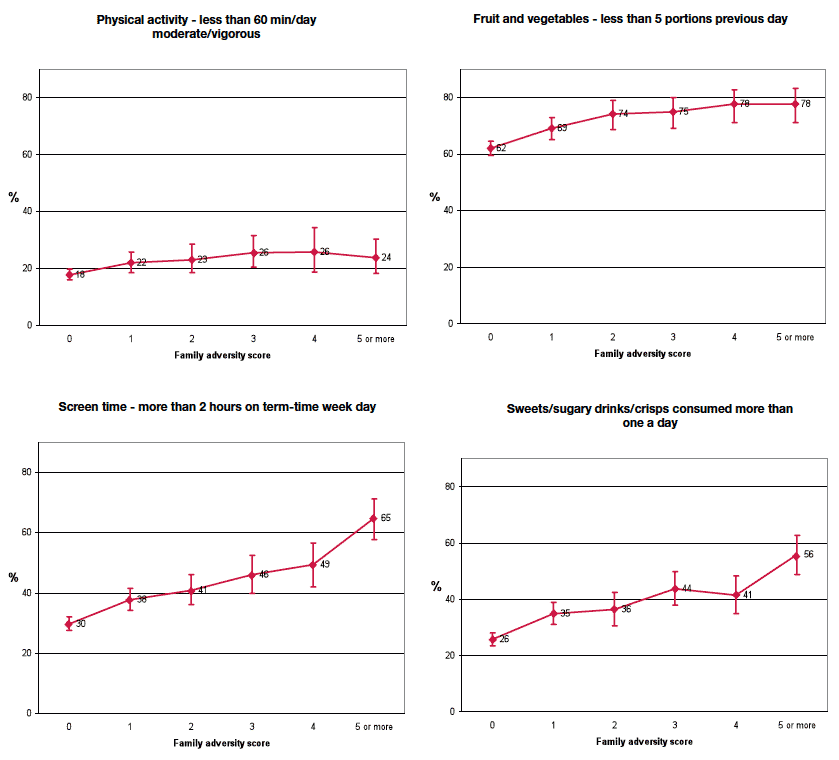
Note: Bars show 95% confidence intervals. Overall, associations between family adversity and poor health behaviours were statistically significant (p<0.001), with the exception of family adversity and physical activity (not significant).
There is a problem
Thanks for your feedback